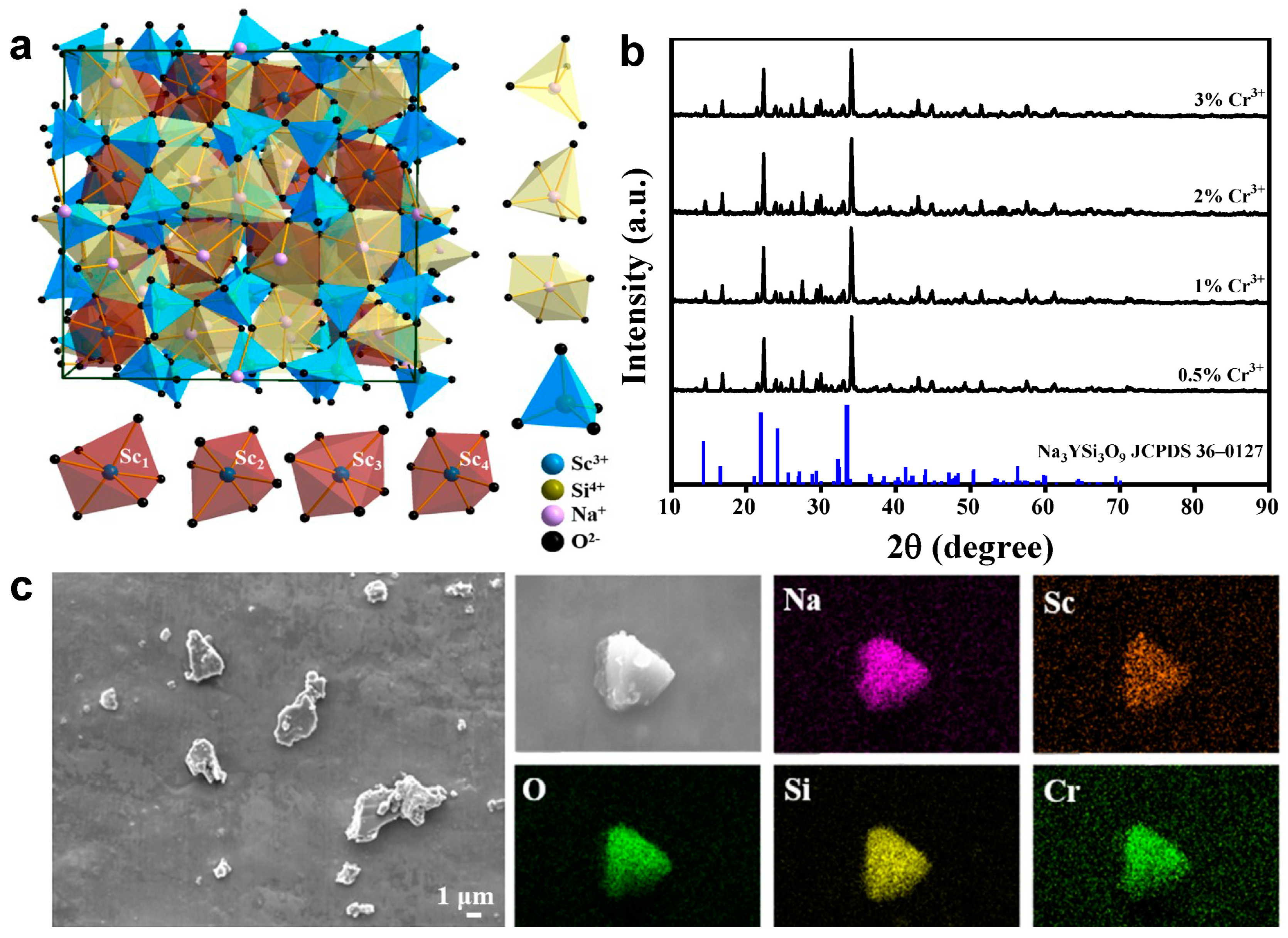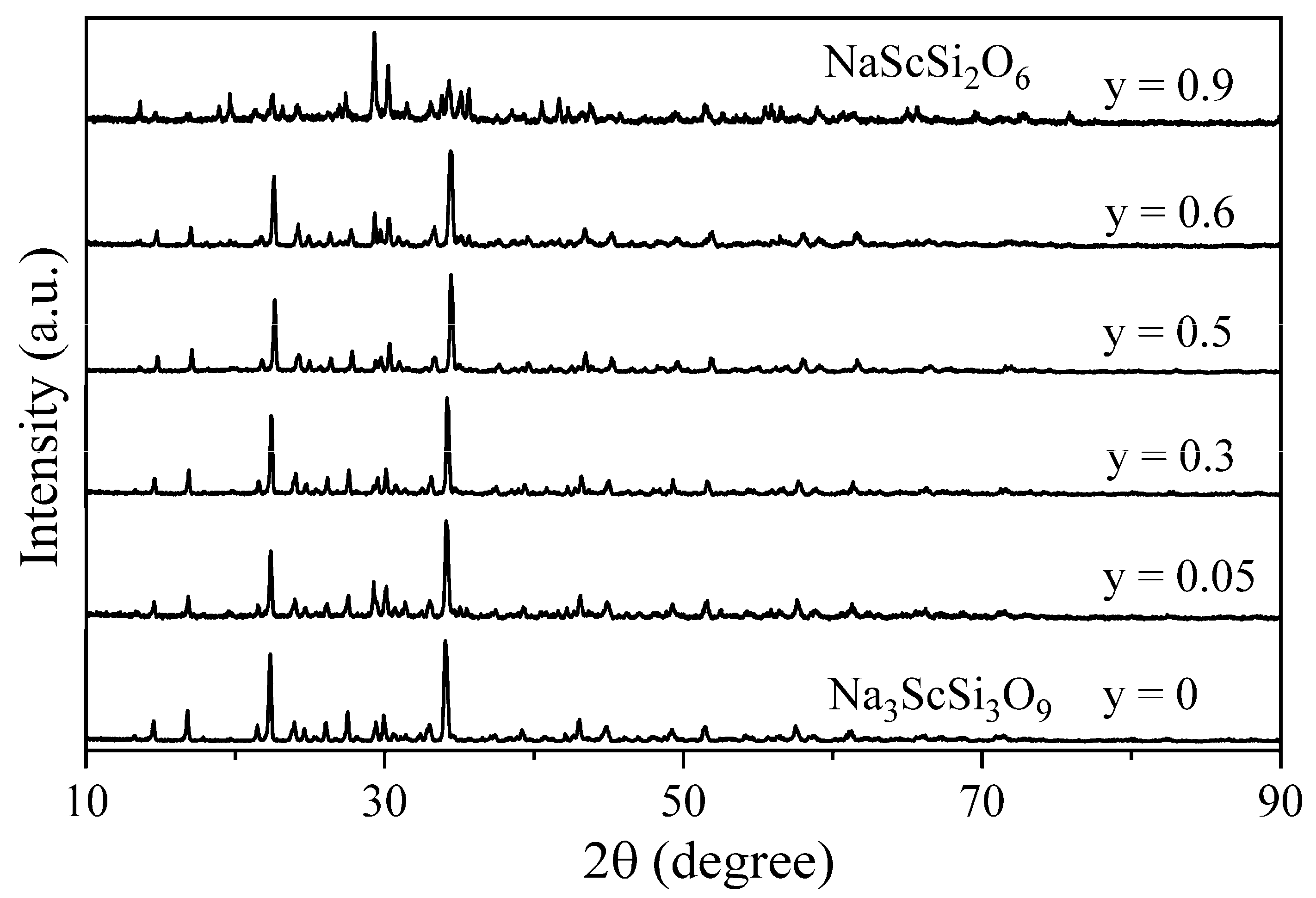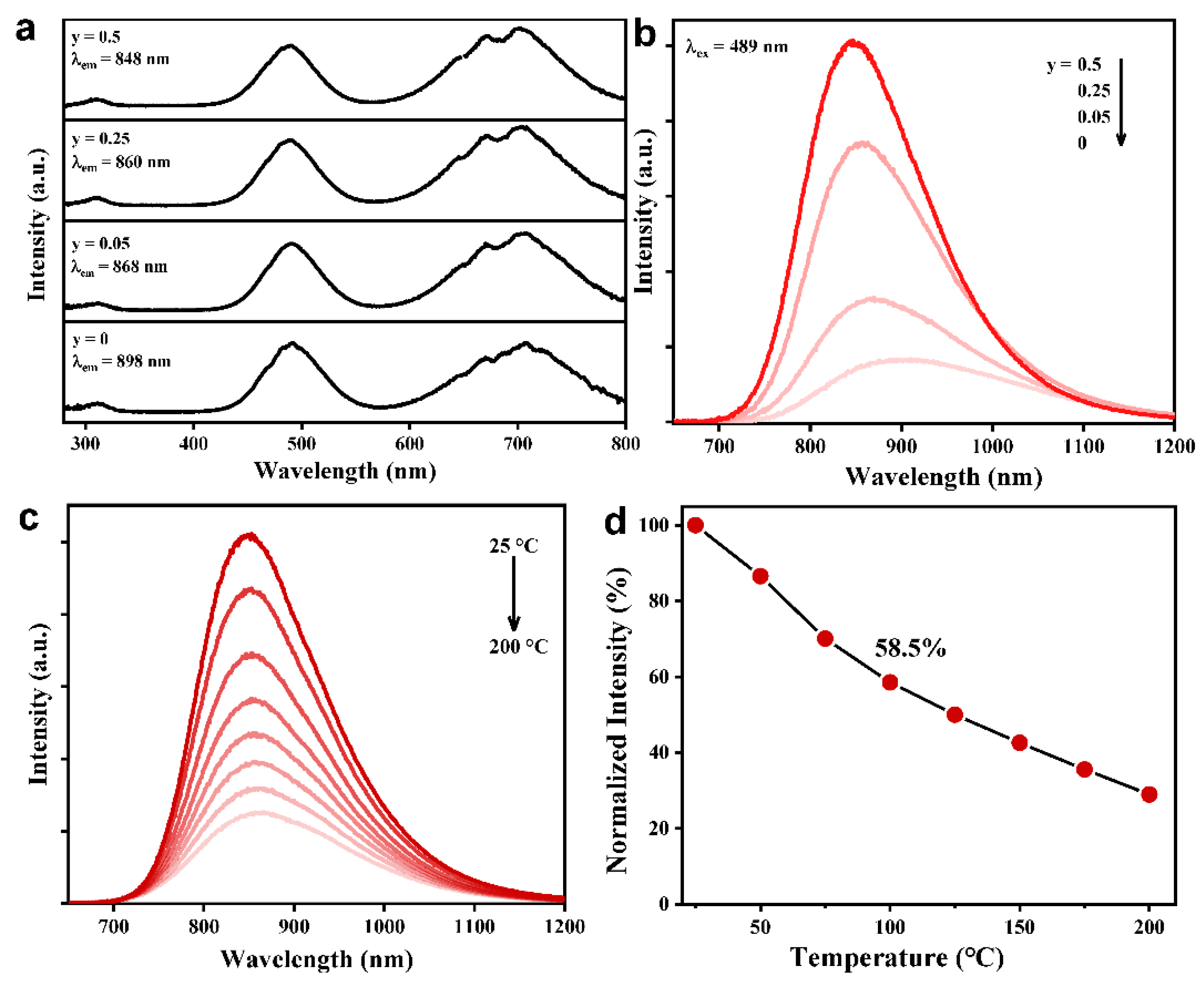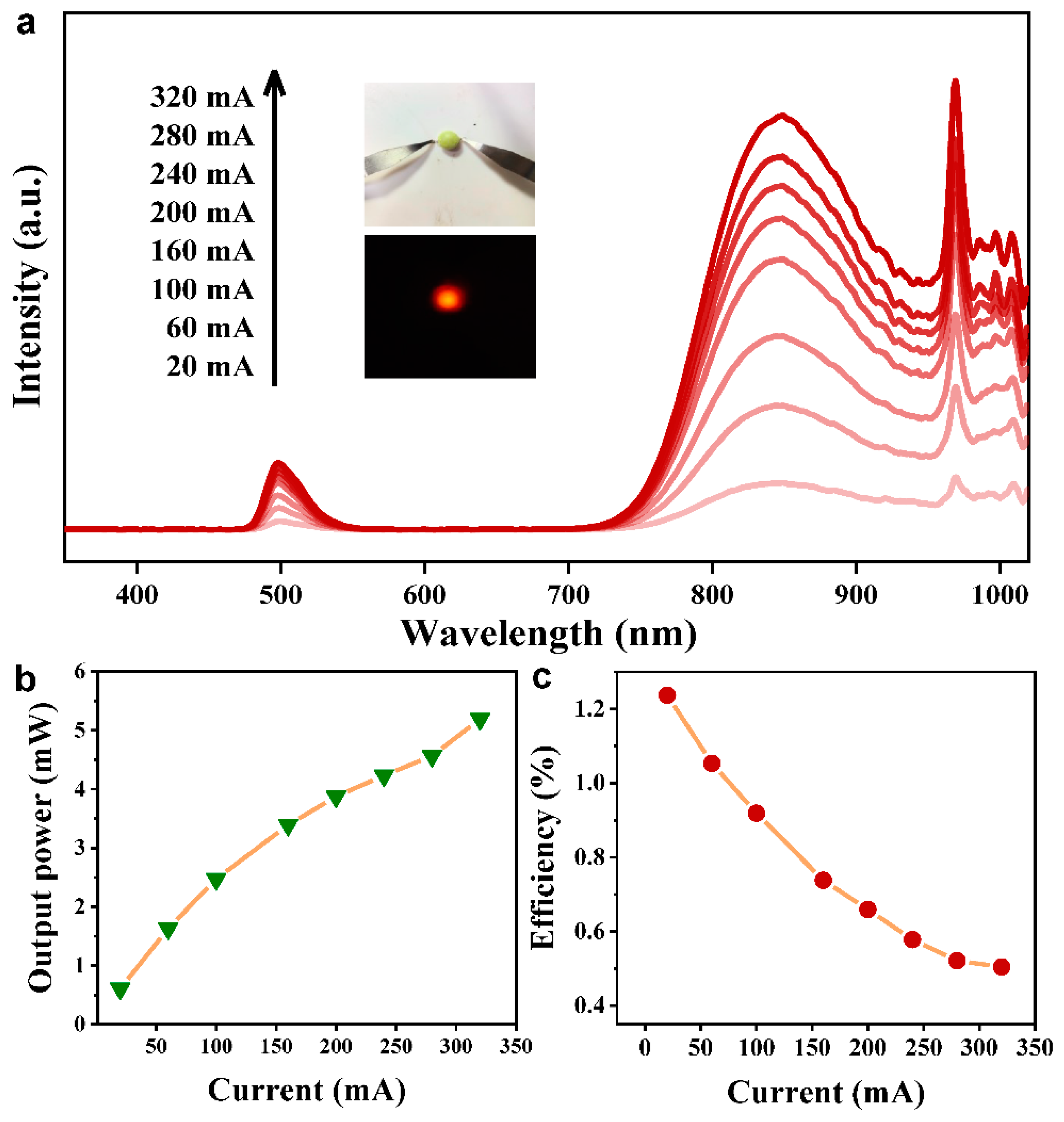Enhancing Infrared Photoluminescence Performance via Li+ Substitution and Yb3+ Codoping in Na3ScSi3O9:Cr3+ Phosphor
Abstract
1. Introduction
2. Experimental Section
2.1. Synthesis
2.2. Fabrication of Phosphor-Converted Infrared LEDs
2.3. Characterization
3. Results and Discussion
3.1. Structural Characterization of the Na3ScSi3O9:Cr3+ Phosphor
3.2. Photoluminescence Properties of the Na3ScSi3O9:Cr3+ Infrared Phosphor
3.3. Structural Characterization and Photoluminescence Properties of the Na3−yLiyScSi3O9:Cr3+ Phosphors
3.4. Enhancing Infrared Photoluminescence Performance by Yb3+ Codoping
3.5. Luminescence Properties of the Fabricated Phosphor-Converted Infrared LEDs
4. Conclusions
Author Contributions
Funding
Institutional Review Board Statement
Informed Consent Statement
Data Availability Statement
Conflicts of Interest
References
- Qiao, J.; Zhang, S.; Zhou, X.; Chen, W.; Gautier, R.; Xia, Z. Near-infrared light-emitting diodes utilizing a europium-activated calcium oxide phosphor with external quantum efficiency of up to 54.7%. Adv. Mater. 2022, 34, 2201887. [Google Scholar] [CrossRef]
- Qiao, J.; Zhou, G.; Zhou, Y.; Zhang, Q.; Xia, Z. Divalent europium-doped near-infrared-emitting phosphor for light-emitting diodes. Nat. Commun. 2019, 10, 5267. [Google Scholar] [CrossRef]
- Liu, D.; Li, G.; Dang, P.; Zhang, Q.; Wei, Y.; Qiu, L.; Molokeev, M.S.; Lian, H.; Shang, M.; Lin, J. Highly efficient Fe3+-doped A2BB′O6 (A = Sr2+, Ca2+; B, B′ = In3+, Sb5+, Sn4+) broadband near-infrared-emitting phosphors for spectroscopic analysis. Light Sci. Appl. 2022, 11, 112. [Google Scholar] [CrossRef]
- Czarnecki, M.A.; Morisawa, Y.; Futami, Y.; Ozaki, Y. Advances in molecular structure and interaction studies using near-infrared spectroscopy. Chem. Rev. 2015, 115, 9707–9744. [Google Scholar] [CrossRef] [PubMed]
- Ding, S.; Guo, H.; Feng, P.; Ye, Q.; Wang, Y. A new near-infrared long persistent luminescence material with its outstanding persistent luminescence performance and promising multifunctional application prospects. Adv. Opt. Mater. 2020, 8, 2000097. [Google Scholar] [CrossRef]
- Tan, T.; Wang, S.; Su, J.; Yuan, W.; Wu, H.; Pang, R.; Wang, J.; Li, C.; Zhang, H. Design of a novel near-infrared luminescence material Li2Mg3TiO6:Cr3+ with an ultrawide tuning range applied to near-infrared light-emitting diodes. ACS Sustain. Chem. Eng. 2022, 10, 3839–3850. [Google Scholar] [CrossRef]
- You, L.; Tian, R.; Zhou, T.; Xie, R.J. Broadband near-infrared phosphor BaMgAl10O17:Cr3+ realized by crystallographic site engineering. Chem. Eng. J. 2021, 417, 129224. [Google Scholar] [CrossRef]
- Liu, G.; Molokeev, M.S.; Lei, B.; Xia, Z. Two-site Cr3+ occupation in the MgTa2O6:Cr3+ phosphor toward broad-band near-infrared emission for vessel visualization. J. Mater. Chem. C 2020, 8, 9322–9328. [Google Scholar] [CrossRef]
- Miao, S.; Liang, Y.; Chen, D.; Shi, R.; Shan, X.; Zhang, Y.; Xie, F.; Wang, X.-J. Site-selective occupancy control of Cr ions toward ultrabroad-band infrared luminescence with a spectral width up to 419 nm. ACS Appl. Mater. Interfaces 2022, 14, 53101–53110. [Google Scholar] [CrossRef]
- Zhong, J.; Li, C.; Zhao, W.; You, S.; Brgoch, J. Accessing high-power near-infrared spectroscopy using Cr3+-substituted metal phosphate phosphors. Chem. Mater. 2022, 34, 337–344. [Google Scholar] [CrossRef]
- He, F.; Song, E.; Zhou, Y.; Ming, H.; Chen, Z.; Wu, J.; Shao, P.; Yang, X.; Xia, Z.; Zhang, Q. A general ammonium salt assisted synthesis strategy for Cr3+-doped hexafluorides with highly efficient near infrared emissions. Adv. Funct. Mater. 2021, 31, 2103743. [Google Scholar] [CrossRef]
- Wen, D.; Liu, H.; Guo, Y.; Zeng, Q.; Wu, M.; Liu, R.-S. Disorder-order conversion-induced enhancement of thermal stability of pyroxene NIR phosphors. Angew. Chem. Int. Ed. 2022, 134, e202204411. [Google Scholar]
- Zou, X.; Wang, X.; Zhang, H.; Kang, Y.; Yang, X.; Zhang, X.; Molokeev, M.S.; Lei, B. A highly efficient and suitable spectral profile Cr3+-doped garnet near-infrared emitting phosphor for regulating photomorphogenesis of plants. Chem. Eng. J. 2022, 428, 132003. [Google Scholar] [CrossRef]
- Liu, D.; Li, G.; Dang, P.; Zhang, Q.; Wei, Y.; Lian, H.; Shang, M.; Lin, C.C.; Lin, J. Simultaneous broadening and enhancement of Cr3+ photoluminescence in LiIn2SbO6 by chemical unit cosubstitution: Night-vision and near-infrared spectroscopy detection applications. Angew. Chem. Int. Ed. 2021, 60, 14644–14649. [Google Scholar] [CrossRef]
- Inkrataite, G.; Laurinavicius, G.; Enseling, D.; Zarkov, A.; Jüstel, T.; Skaudzius, R. Characterization of GAGG doped with extremely low levels of chromium and exhibiting exceptional intensity of emission in NIR region. Crystals 2021, 11, 673. [Google Scholar] [CrossRef]
- Zhang, Y.; Li, X.; Hu, D.; Sa, Q.; Wang, X.; Wang, F.; Wang, K.; Zhou, X.; Song, Z.; Liu, Y.; et al. Enhanced photoluminescence of Gd3Al4GaO12:Cr3+ by energy transfers from co-doped Dy3+. Nanomaterials 2022, 12, 4183. [Google Scholar] [CrossRef]
- Chen, L.; Wu, Y.; Liu, Q.; Guo, Y.; Liu, F.; Wang, B.; Wei, S. Energy conversion and transfer in the luminescence of CeSc3(BO3)4:Cr3+ phosphor. Materials 2023, 16, 1231. [Google Scholar] [CrossRef]
- Jia, Z.; Yuan, C.; Liu, Y.; Wang, X.-J.; Sun, P.; Wang, L.; Jiang, H.; Jiang, J. Strategies to approach high performance in Cr3+-doped phosphors for high-power NIR-LED light sources. Light: Sci. Appl. 2020, 9, 86. [Google Scholar] [CrossRef]
- Xiao, H.; Zhang, J.; Zhang, L.; Wu, H.; Wu, H.; Pan, G.; Liu, F.; Zhang, J. Cr3+ activated garnet phosphor with efficient blue to far-red conversion for pc-LED. Adv. Opt. Mater. 2021, 9, 2101134. [Google Scholar] [CrossRef]
- Zhou, L.; Lyu, Z.; Sun, D.; Shen, S.; Tan, T.; Wang, L.; Zhao, H.; You, H. Enhanced thermal stability and energy transfer by crystal-field engineering in a garnet phosphor for thermometry and NIR-LED. Adv. Opt. Mater. 2022, 10, 2201308. [Google Scholar] [CrossRef]
- Feng, X.; Lin, L.; Duan, R.; Qiu, J.; Zhou, S. Transition metal ion activated near-infrared luminescent materials. Prog. Mater. Sci. 2022, 129, 100973. [Google Scholar] [CrossRef]
- Liu, S.; Zheng, Y.; Peng, D.; Zhao, J.; Song, Z.; Liu, Q. Near-infrared mechanoluminescence of Cr3+ doped gallate spinel and magnetoplumbite smart materials. Adv. Funct. Mater. 2023, 33, 2209275. [Google Scholar] [CrossRef]
- Wang, Y.; Wang, Z.; Wei, G.; Yang, Y.; He, S.; Li, J.; Shi, Y.; Li, R.; Zhang, J.; Li, P. Ultra-broadband and high efficiency near-infrared Gd3ZnxGa5-2xGexO12:Cr3+ (x = 0–2.0) garnet phosphors via crystal field engineering. Chem. Eng. J. 2022, 437, 135346. [Google Scholar] [CrossRef]
- Miao, S.; Liang, Y.; Zhang, Y.; Chen, D.; Yan, S.; Liu, J.; Wang, X.-J. Spectrally tunable and thermally stable near-infrared luminescence in Na3Sc2(PO4)3:Cr3+ phosphors by Ga3+ co-doping for light-emitting diodes. J. Mater. Chem. C 2022, 10, 994–1002. [Google Scholar] [CrossRef]
- Fang, M.-H.; Chen, K.-C.; Majewska, N.; Leśniewski, T.; Mahlik, S.; Leniec, G.; Kaczmarek, S.M.; Yang, C.-W.; Lu, K.-M.; Sheu, H.-S.; et al. Hidden structural evolution and bond valence control in near-infrared phosphors for light-emitting diodes. ACS Energy Lett. 2021, 6, 109–114. [Google Scholar] [CrossRef]
- Zhao, M.; Liu, S.; Cai, H.; Zhao, F.; Song, Z.; Liu, Q. Cr3+-doped double perovskite antimonates: Efficient and tunable phosphors from NIR-I to NIR-II. Inorg. Chem. Front. 2022, 9, 4602–4607. [Google Scholar] [CrossRef]
- Yao, L.; Jia, Q.; Yu, S.; Liang, C.; Jiang, J.; Shao, Q. Simultaneous absorption and near-infrared emission enhancement of Cr3+ ions in MgGa2O4 spinel oxide via anionic F-substitution. Adv. Opt. Mater. 2023, 11, 2202458. [Google Scholar] [CrossRef]
- Feng, J.; Liu, H.; Ma, Z.; Feng, J.; Chen, L.; Li, J.; Cai, Y.; Zeng, Q.; Wen, D.; Guo, Y. A super stable near-infrared garnet phosphor resistant to thermal quenching, thermal degradation and hydrolysis. Chem. Eng. J. 2022, 449, 137892. [Google Scholar] [CrossRef]
- Li, C.; Zhong, J. Highly efficient broadband near-infrared luminescence with zero-thermal-quenching in garnet Y3In2Ga3O12:Cr3+ phosphors. Chem. Mater. 2022, 34, 8418–8426. [Google Scholar] [CrossRef]
- He, S.; Zhang, L.; Wu, H.; Wu, H.; Pan, G.; Hao, Z.; Zhang, X.; Zhang, L.; Zhang, H.; Zhang, J. Efficient super broadband NIR Ca2LuZr2Al3O12:Cr3+,Yb3+ garnet phosphor for pc-LED light source toward NIR spectroscopy applications. Adv. Opt. Mater. 2020, 8, 1901684. [Google Scholar] [CrossRef]
- Basore, E.T.; Wu, H.; Xiao, W.; Zheng, G.; Liu, X.; Qiu, J. High-power broadband NIR LEDs enabled by highly efficient blue-to-NIR conversion. Adv. Opt. Mater. 2021, 9, 2001660. [Google Scholar] [CrossRef]
- Zhang, Y.; Miao, S.; Liang, Y.; Liang, C.; Chen, D.; Shan, X.; Sun, K.; Wang, X.-J. Blue LED-pumped intense short-wave infrared luminescence based on Cr3+-Yb3+-co-doped phosphors. Light Sci. Appl. 2022, 11, 136. [Google Scholar] [CrossRef] [PubMed]
- Wei, G.; Wang, Z.; Li, R.; Wang, Y.; Li, J.; Shi, Y.; He, S.; Yang, Y.; Yang, Z.; Li, P. Enhancement of near-infrared phosphor luminescence properties via construction of stable and compact energy transfer paths. Adv. Opt. Mater. 2022, 10, 2201076. [Google Scholar] [CrossRef]
- Yao, L.; Shao, Q.; Han, S.; Liang, C.; He, J.; Jiang, J. Enhancing near-infrared photoluminescence intensity and spectral properties in Yb3+ codoped LiScP2O7:Cr3+. Chem. Mater. 2020, 32, 2430–2439. [Google Scholar] [CrossRef]
- Shi, R.; Miao, S.; Zhang, Y.; Lv, X.; Chen, D.; Liang, Y. Blue-light-excitable pure and efficient short-wave infrared luminescence via Cr3+→Yb3+ energy transfer in a KYbP2O7:Cr3+ phosphor. J. Mater. Chem. C 2023, 11, 2748–2755. [Google Scholar] [CrossRef]
- Miao, S.; Liang, Y.; Zhang, Y.; Chen, D.; Wang, X.-J. Broadband short-wave infrared light-emitting diodes based on Cr3+-doped LiScGeO4 phosphor. ACS Appl. Mater. Interfaces 2021, 13, 36011–36019. [Google Scholar] [CrossRef]
- Liu, G.; Xia, Z. Modulation of thermally stable photoluminescence in Cr3+-based near-infrared phosphors. J. Phys. Chem. Lett. 2022, 13, 5001–5008. [Google Scholar] [CrossRef]
- Zhang, G.; Wang, D.; Ren, J.; Zhou, X.; Wang, Y. Highly efficient broadband near-infrared emission from Sn2+ alloyed lead-free cesium zinc halides. Laser Photonics Rev. 2023, 2300158. [Google Scholar] [CrossRef]







Disclaimer/Publisher’s Note: The statements, opinions and data contained in all publications are solely those of the individual author(s) and contributor(s) and not of MDPI and/or the editor(s). MDPI and/or the editor(s) disclaim responsibility for any injury to people or property resulting from any ideas, methods, instructions or products referred to in the content. |
© 2023 by the authors. Licensee MDPI, Basel, Switzerland. This article is an open access article distributed under the terms and conditions of the Creative Commons Attribution (CC BY) license (https://creativecommons.org/licenses/by/4.0/).
Share and Cite
Zhang, Z.; Liang, Y. Enhancing Infrared Photoluminescence Performance via Li+ Substitution and Yb3+ Codoping in Na3ScSi3O9:Cr3+ Phosphor. Crystals 2023, 13, 1000. https://doi.org/10.3390/cryst13071000
Zhang Z, Liang Y. Enhancing Infrared Photoluminescence Performance via Li+ Substitution and Yb3+ Codoping in Na3ScSi3O9:Cr3+ Phosphor. Crystals. 2023; 13(7):1000. https://doi.org/10.3390/cryst13071000
Chicago/Turabian StyleZhang, Zhuanzhuan, and Yanjie Liang. 2023. "Enhancing Infrared Photoluminescence Performance via Li+ Substitution and Yb3+ Codoping in Na3ScSi3O9:Cr3+ Phosphor" Crystals 13, no. 7: 1000. https://doi.org/10.3390/cryst13071000
APA StyleZhang, Z., & Liang, Y. (2023). Enhancing Infrared Photoluminescence Performance via Li+ Substitution and Yb3+ Codoping in Na3ScSi3O9:Cr3+ Phosphor. Crystals, 13(7), 1000. https://doi.org/10.3390/cryst13071000









